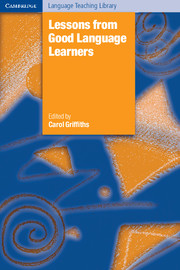Book contents
- Frontmatter
- Contents
- List of contributors
- Acknowledgements
- Editor's overview
- Prologue
- Reflections
- Part I Learner variables
- 1 Motivation and good language learners
- 2 Age and good language learners
- 3 Learning style and good laguage learners
- 4 Personality and good language learners
- 5 Gender and good language learners
- 6 Strategies and good language learners
- 7 Metacognition and good language learners
- 8 Autonomy and good language learners
- 9 Beliefs and good language learners
- 10 Culture and good language learners
- 11 Aptitude and good language learners
- Part II Learning variables
- The learners' landscape and journey: a summary
- Index
3 - Learning style and good laguage learners
Published online by Cambridge University Press: 11 August 2009
- Frontmatter
- Contents
- List of contributors
- Acknowledgements
- Editor's overview
- Prologue
- Reflections
- Part I Learner variables
- 1 Motivation and good language learners
- 2 Age and good language learners
- 3 Learning style and good laguage learners
- 4 Personality and good language learners
- 5 Gender and good language learners
- 6 Strategies and good language learners
- 7 Metacognition and good language learners
- 8 Autonomy and good language learners
- 9 Beliefs and good language learners
- 10 Culture and good language learners
- 11 Aptitude and good language learners
- Part II Learning variables
- The learners' landscape and journey: a summary
- Index
Summary
An enduring question for language researchers is the effect of individual differences on the efficacy of language learning. For example, learners differ from one another in the ways in which they process information from the environment. This proposition of individual differences in information processing is the cornerstone of research on learning styles – which have been defined as learners' “consistent ways of responding to and using stimuli in the context of learning” (Claxton and Ralston, 1978, p. 7) and as their “natural, habitual, and preferred ways of absorbing, processing, and retaining new information and skills which persist regardless of teaching methods or content area” (Kinsella, 1995, p. 171).
The learning style concept
Although it was from psychology that many of the central concepts and theories relating to learning styles originated, in more recent years, research in the area of learning styles has been conducted in domains outside psychology. Several attempts to integrate and synthesize the conceptual field have been made (for instance, Cassidy, 2004; Curry, 1983, 1987, 2000; Jonassen and Grabowski, 1993; Rayner and Riding, 1997; Riding and Cheema, 1991). However, the question of how the style literature should be integrated and organized is still being posed by researchers and teachers alike (for instance, Coffield, Moseley, Hall and Ecclestone, 2004; Desmedt and Valcke, 2004).
- Type
- Chapter
- Information
- Lessons from Good Language Learners , pp. 49 - 60Publisher: Cambridge University PressPrint publication year: 2008
- 7
- Cited by



